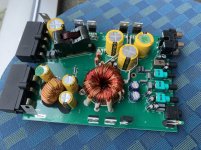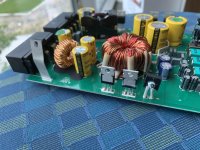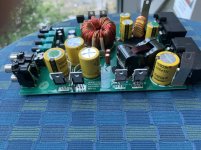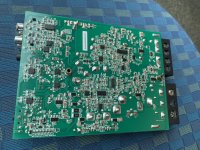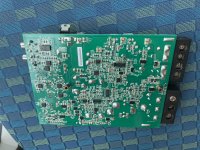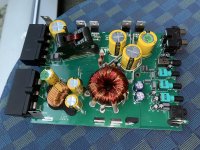I was dumb and swapped the 12V+ and GND in a hurry to go out to eat on Mothers Day. I dont see anything instantly that jumps out maybe someone can see something. I get no lights or sound when connected properly now.
Thank you in advance.
Thank you in advance.
Attachments
While you have the mosfets pulled you will want to check the driver IC3-18021. If the mosfets are blown most likely the driver is also. Post the Ohmmeter measurements, Black probe to power ground. Check both the IC3 and IC2-TL494 on all pins and list as follows:
IC2
1-
2-
3-
etc
IC3
1-
2-
3-
etc
What test equipment and tools do you have?Oscilloscope,DVM,VOM, power supply,soldering iron?
Some idea about your skill level will be helpful, so to offer better advice.
IC2
1-
2-
3-
etc
IC3
1-
2-
3-
etc
What test equipment and tools do you have?Oscilloscope,DVM,VOM, power supply,soldering iron?
Some idea about your skill level will be helpful, so to offer better advice.
I tested b+ to GND . It started at 4.5k ohms but kept climbing slowly after about 30 seconds was at 9.5k.
I haven't been able to pull FETS yet because I work in the Silicon Valley (IT Tech since 1995) and my de solder station is 3 hours away in Fresno. I'll be home Saturday night to work on the amp.
I have DMM , irons, de solder pump that connects to my shop compressor with a foot switch. I MIGHT have an osiliscope as my dad was a repair tech for Schlumberger since he left Atari but retired recently and has a bunch of equipment at the house.
As for PSU I modified an ATX PSU to get 12v for testing head units and other projects.
I have built cmoys and gainclones and also a tube amp (project sunrise).. Some were etched in my garage with laser toner transfer until I bought the audiosector PCBs . I learned etching in highschool I had 4 years of electronics class as my elective. I guess what I'm trying to convey is I have a basic understanding of electronics, but I honestly I just follow directions pretty well.
I haven't been able to pull FETS yet because I work in the Silicon Valley (IT Tech since 1995) and my de solder station is 3 hours away in Fresno. I'll be home Saturday night to work on the amp.
I have DMM , irons, de solder pump that connects to my shop compressor with a foot switch. I MIGHT have an osiliscope as my dad was a repair tech for Schlumberger since he left Atari but retired recently and has a bunch of equipment at the house.
As for PSU I modified an ATX PSU to get 12v for testing head units and other projects.
I have built cmoys and gainclones and also a tube amp (project sunrise).. Some were etched in my garage with laser toner transfer until I bought the audiosector PCBs . I learned etching in highschool I had 4 years of electronics class as my elective. I guess what I'm trying to convey is I have a basic understanding of electronics, but I honestly I just follow directions pretty well.
Oh also, it doesn't blow the fuse when in correct polarity, but perhaps the fuse is too large or slow. I only waited about 30 seconds to a minute after the front amp started playing music before removing REM though. Thank you for taking the time to help me with this. I'm hoping to learn how to troubleshoot amps myself as I have a usacoustics 2050 I messed up trying to swap the opamp to a burr brown. This was before I knew that it was a Zed amp  . So if possible a slight explanation of what we are looking for and why on the tests, so I don't have to take the forums time for the basic stuff. I truly appreciate the help on such a low cost amp. I figured I would learn on this one and then proceed to the more expensive amps I need to fix. The 2050 and also a Kicker ZR240 with only one working channel.
. So if possible a slight explanation of what we are looking for and why on the tests, so I don't have to take the forums time for the basic stuff. I truly appreciate the help on such a low cost amp. I figured I would learn on this one and then proceed to the more expensive amps I need to fix. The 2050 and also a Kicker ZR240 with only one working channel.
AGU is OK but there are problems with a lot of the AGU fuse holders. That said, for a small amp like this, the AGU should be OK.
A better option would be a plug-in type fuse with a good fuse holder. For larger amps, the fuse and fuse holder are more critical. What's important is to use a fuse that's rated low enough to offer the best protection to this amp. The owner's manual calls for a 40 amp. A 30 would likely be enough in a MAXI type fuse.
A better option would be a plug-in type fuse with a good fuse holder. For larger amps, the fuse and fuse holder are more critical. What's important is to use a fuse that's rated low enough to offer the best protection to this amp. The owner's manual calls for a 40 amp. A 30 would likely be enough in a MAXI type fuse.
Awesome, I was planning on also reducing the fuses on the other amp and also my Arc 1100.5 in my other car after reading a blog by, I "think" it was Zed, which recommended using fuses just large enough based on the gain actually being run for extra protection. Using what common sense I have, the cxa300.1 has proven otherwise lol, it sounded like a solid theory. Seeing your advice if a 30amp fuse for this one reminded me of that article and then I remembered Mother's day when I was overly excited to test out the amp, noticed there wasn't a fuse and said hmmm is it inside or do I need to get one... "Well, it's just a test and I have a fuse up front anyway..." *Shame* .... 4guage kit came with a 80amp fuse :'(
So just to make sure I understand correctly, even though I don't have 0 ohms on B+ to GND... I should still pull the FETS tomorrow then get the IC measurements requested earlier. You had mentioned If I had 0 ohms to pull and test.
So just to make sure I understand correctly, even though I don't have 0 ohms on B+ to GND... I should still pull the FETS tomorrow then get the IC measurements requested earlier. You had mentioned If I had 0 ohms to pull and test.
I understood that it was blowing the fuse when wired correctly. Generally, when an amp is blowing the fuse before remote is applied, it has a short across B+ and ground. That short is typically the PS FETs or the RP (reverse protection) diode. Pulling the FETs would have allowed you to see which it was.
If the amp is not doing anything, It's possible that the FETs opened internally. They generally make a mess when doing this but sometimes not. You can remove them and check them.
At some point, you may be asked to check the voltage at various points in the circuit with the amp powered up. You should have a low-rated fuse (5 -10A) or a current limiter in series with the B+ line to help protect the amp in case your probes slip or in case there is another problem.
If the amp is not doing anything, It's possible that the FETs opened internally. They generally make a mess when doing this but sometimes not. You can remove them and check them.
At some point, you may be asked to check the voltage at various points in the circuit with the amp powered up. You should have a low-rated fuse (5 -10A) or a current limiter in series with the B+ line to help protect the amp in case your probes slip or in case there is another problem.
My guess is the mosfets opened up and took at the driver IC 18021. After removing and checking the mosfets. Do the ohmmeter check I suggested earlier when you can.
If and when you have to replace the mosfets and IC, the following are mouser links you can use. Note the AOT460 is obsolete and Mouser gives a cross reference to IRF1018EPBF. I have no experience with this device, someone else may be able to chime in with a replacement suggestion.
IRF1018EPBF Infineon Technologies | Mouser
MP18021HN-LF-Z Monolithic Power Systems (MPS) | Mouser
If and when you have to replace the mosfets and IC, the following are mouser links you can use. Note the AOT460 is obsolete and Mouser gives a cross reference to IRF1018EPBF. I have no experience with this device, someone else may be able to chime in with a replacement suggestion.
IRF1018EPBF Infineon Technologies | Mouser
MP18021HN-LF-Z Monolithic Power Systems (MPS) | Mouser
all ohm readings in k...
b+ to ground with transistors out 1.49 then climbing
IC2
1-2.08
2-1.99
3-16.27
4-4.02
5-open
6-3.38
7-1.41
8-1.73
9-1.56
10-1.56
11-1.73
12-6.24
13-1.72
14-1.72
15-2.88
16-7.67
IC3
1-6.40
2-6.40
3-3.6
4-1.42
5-1.57
6-1.42
7-1.57
8-3.55
aot460 - DS 1.776 , DS 1.776 open when leads reversed
aot412 - DS 1.33 , DS 1.38 open when reversed
mur1620ct - black on center pin 1.208 , 1.266 open when reversed
mur1620ctr - red on center pin 1.187, 1.187 open when reversed
b+ to ground with transistors out 1.49 then climbing
IC2
1-2.08
2-1.99
3-16.27
4-4.02
5-open
6-3.38
7-1.41
8-1.73
9-1.56
10-1.56
11-1.73
12-6.24
13-1.72
14-1.72
15-2.88
16-7.67
IC3
1-6.40
2-6.40
3-3.6
4-1.42
5-1.57
6-1.42
7-1.57
8-3.55
aot460 - DS 1.776 , DS 1.776 open when leads reversed
aot412 - DS 1.33 , DS 1.38 open when reversed
mur1620ct - black on center pin 1.208 , 1.266 open when reversed
mur1620ctr - red on center pin 1.187, 1.187 open when reversed
Updated test numbers.
Sorry for the incorrect readings earlier my dmm wasn’t zero’d pls ignore my last post .. see new readings below...
QUOTE=zinoyracer;5795819]all ohm readings in k...
b+ to ground with transistors out 1.49 then climbing
1-5.6k
2-4
3-.709M
4-21.7k
5-open
6-16.44k
7-.9
8-2.66k
9-1.23k
10-1.23k
11.-2.7k
12-42.5k
13-2.7k
14-2.7k
15-12.4
16-51.7
IC3
1-42.5j
2-43.2k
3-19.3k
4-1.0
5-1.22k
6-1.22k
7= 1ohm
8-19
aot460 - DS 1.1M DS 1.228 open when leads reversed
aot412 - DS .975M x DS 1.38 open when reversed
mur1620ct - black on center pin .881M , .893 open when reversed
mur1620ctr - red on center pin .477M, .747M open when reversed[/QUOTE]
Sorry for the incorrect readings earlier my dmm wasn’t zero’d pls ignore my last post .. see new readings below...
QUOTE=zinoyracer;5795819]all ohm readings in k...
b+ to ground with transistors out 1.49 then climbing
1-5.6k
2-4
3-.709M
4-21.7k
5-open
6-16.44k
7-.9
8-2.66k
9-1.23k
10-1.23k
11.-2.7k
12-42.5k
13-2.7k
14-2.7k
15-12.4
16-51.7
IC3
1-42.5j
2-43.2k
3-19.3k
4-1.0
5-1.22k
6-1.22k
7= 1ohm
8-19
aot460 - DS 1.1M DS 1.228 open when leads reversed
aot412 - DS .975M x DS 1.38 open when reversed
mur1620ct - black on center pin .881M , .893 open when reversed
mur1620ctr - red on center pin .477M, .747M open when reversed[/QUOTE]
For most transistors, it's best to test as follows.
Terminal numbers:
1-2:
1-3:
2-3
Reverse probes
1-2:
1-3:
2-3
If you want to be sure that there is no confusion, change from ohms to diode-check and repeat. I realize that this is a bit much to post. If nothing else, do this when checking them for yourself. When you don't have to post the numbers, it takes longer to change meter modes than it does to do the tests.
For testing 2-3 on FETs, it reduces the chance of errors if you short leg 1-3 with a jumper.
This is just an FYI. No need to repost.
Terminal numbers:
1-2:
1-3:
2-3
Reverse probes
1-2:
1-3:
2-3
If you want to be sure that there is no confusion, change from ohms to diode-check and repeat. I realize that this is a bit much to post. If nothing else, do this when checking them for yourself. When you don't have to post the numbers, it takes longer to change meter modes than it does to do the tests.
For testing 2-3 on FETs, it reduces the chance of errors if you short leg 1-3 with a jumper.
This is just an FYI. No need to repost.
Based on the readings the IC's appear to be good. I was mainly concerned with IC3 and Pins 3 & 8. I'm assuming that pin 8 is 19kohm(Pin 3-19.3Kohm) and not 19ohms. If it is that low then the 18021 is shorted internally.
If Pin 8 is 19Kohm then check R105-4.7ohms. This resistor may have burned and the value has increased, if so you will need to replace the 18021 and mosfets as well,
If R105 is in value the next step will to be measure the DC voltages around the IC3 and IC2, again using power ground for the black probe.You will won't to leave the AOT460's out, and remove R68-4.7Kohm. This is the sense resistor for the shutdown circuit. Use Perry's instructions I've quoted below. With no power supply mosfets you shouldn't have an issue.Use common sense and be prepared to shut down the power if necessary. Post your readings as you did before.
At some point, you may be asked to check the voltage at various points in the circuit with the amp powered up. You should have a low-rated fuse (5 -10A) or a current limiter in series with the B+ line to help protect the amp in case your probes slip or in case there is another problem.
If Pin 8 is 19Kohm then check R105-4.7ohms. This resistor may have burned and the value has increased, if so you will need to replace the 18021 and mosfets as well,
If R105 is in value the next step will to be measure the DC voltages around the IC3 and IC2, again using power ground for the black probe.You will won't to leave the AOT460's out, and remove R68-4.7Kohm. This is the sense resistor for the shutdown circuit. Use Perry's instructions I've quoted below. With no power supply mosfets you shouldn't have an issue.Use common sense and be prepared to shut down the power if necessary. Post your readings as you did before.
At some point, you may be asked to check the voltage at various points in the circuit with the amp powered up. You should have a low-rated fuse (5 -10A) or a current limiter in series with the B+ line to help protect the amp in case your probes slip or in case there is another problem.
- Status
- This old topic is closed. If you want to reopen this topic, contact a moderator using the "Report Post" button.
- Home
- General Interest
- Car Audio
- Dead CXA300.1
